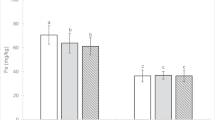Abstract
In the SE periphery of Brazilian Amazonia, low-input agriculture systems on sandy loam soils have very low nutrient use efficiency. In a low-input alley cropping system, we measured residue decomposition dynamics and the yield and nutrient uptake of a maize crop associated with the following treatments: Clitoria + Pigeon pea; Acacia + Pigeon pea; Leucaena + Clitoria; Leucaena + Acacia, Leucaena + Pigeon pea and no residue input (control). The acacia treatments provided better soil coverage throughout the whole corn cycle. Potassium was released faster than nitrogen from the residues; N concentration in corn leaves in the residue treatments were below critical levels. The Leucaena + Acacia treatment was the most effective in increasing post-tasseling N and K assimilation and K use efficiency. This resulted in corn productivity 3.5 times greater (7.3 Mg ha−1) than the control without residue application. In the Amazonian sandy loam soils, which are susceptible to hardsetting and nutrient leaching, efficient N and K use should be priorities for soil management. Although no-till alley cropping of leguminous trees constitutes an important option for low-input farming, its efficiency depends on using a mixture of residues that keeps soil covered and have high rates of both N and K release during the entire crop cycle.




Similar content being viewed by others
References
Aguiar ACF, Bicudo SJ, Costa Sobrinho JRS, Martins ALS, Coelho KP, Moura EG (2010) Nutrient recycling and physical indicators of an alley cropping system in a sandy loam soil in the Pre-Amazon region of Brazil. Nutr Cycl Agroecosyst 86:189–198
Atta-Krah AN (1989) Alley farming with leucaena: effects of short grazed fallows on soil fertility and crop yields. Expl Agric 1:1–10
Becher HH, Breuer J, Klingler B (1997) An index value for characterizing hardsetting soils by fall-cone penetration. Soil Tech 10:47–56
Berchtold A, Besson JM, Feller U (1993) Effects of fertilization levels in two farming systems on senescence and nutrient contents in potato leaves. Plant Soil 154:81–88
Buresh RJ, Tian G (1998) Soil improvement by trees in sub-Saharan Africa. Agroforest Syst 38:51–76
Dechert G, Veldkamp E, Brumme R (2005) Are partial nutrient balances suitable to evaluate nutrient sustainability of land use systems? Results from a case study in Central Sulawesi, Indonesia. Nutr Cycl Agroecosyst 72:201–212
Drinkwater LE, Snapp SS (2007) Nutrients in agroecosystems: rethinking the management paradigm. Adv Agron 92:163–186
Fosu M, Kühne RF, Vlek PLG (2007) Mineralization and microbial biomass dynamics during decomposition of four leguminous residues. J Biol Sci 7:632–637
IAC (2001) Análise química para avaliação da fertilidade de solos tropicais. IAC, Campinas
Leite AAL, Ferraz Júnior ASL, Moura EG, Aguiar ACF (2008) Comportamento de dois genótipos de milho cultivados em sistema de aléias pré-estabelecidos com diferentes leguminosas arbóreas. Bragantia 67:817–825
Mendonça ES, Stott DE (2003) Characteristics and decomposition rates of pruning residues from a shaded coffee system in Southeastern Brazil. Agroforest Syst 57:117–125
Moura EG, Albuquerque JM, Aguiar ACF (2008) Growth and productivity of corn as affected by mulching and tillage in alley cropping systems. Sci Agric 65:204–208
Moura EG, Coelho KP, Freitas IC, Aguiar ACF (2009a) Chemical and physical fertility indicators of a weakly-structured tropical soil after liming and mulching. Sci Agric 66:800–805
Moura EG, Moura NG, Marques ES, Pinheiro KM, Costa Sobrinho JRS, Aguiar ACF (2009b) Evaluating chemical and physical quality indicators for a structurally fragile tropical soil. Soil Use Manage 25:368–375
Mullins CE (1999) Hardsetting soils. In: Summer ME (ed) Handbook of soil science. CRC Press, New York, pp G65–G87
Myers RJK, Van Noordwijk M, Vityakon P (1997) Synchrony of nutrient release and plant demand: plant litter quality, soil environment and farmer management options. In: Cadisch G, Giller KE (eds) Driven by Nature: plant litter quality and decomposition. CAB International, United Kingdom
Ribeiro AC, Guimarães PTG, Alvarez VHV (1999) Recomendações para o uso de corretivos e fertilizantes em Minas Gerais – 5a Aproximação. UFV: Viçosa
SAEG (2007) Sistema para análises estatísticas. Versão 9.1. Viçosa, MG, Fundação Arthur Bernardes/Universidade Federal de Viçosa
Sawyer JE, Mallarino AP (2002) Corn leaf potassium deficiency symptoms. In: The Integrated Crop Management Newsletter. IC-488(15). Iowa State Univ. Extension
Spiertz JHJ (1983) Agronomical and physiological aspects of the role of nitrogen in yield formation of cereals. Plant Soil 75:379–391
Tedesco MJ, Gianello C, Bissani CA, Bohnen H, Volkweiss SJ (1995) Análise de solos, plantas e outros materiais. UFRGS, Porto Alegre
Vanlauwe B, Diels J, Sanginga N, Merckx R (2005) Long-term integrated soil fertility management in South-western Nigeria: crop performance and impact on the soil fertility status. Plant Soil 273:337–354
Van Raij B, Cantarella H, Quaggio JA, Furlani AMC (1996) Recomendações de adubação e calagem para o Estado de São Paulo. 2.ed. Campinas: Instituto Agronômico & Fundação IAC. p 285
Yang XE, Liu JX, Wang WM, Yez Q, Luo AC (2004) Potassium internal use efficiency relative to growth vigor, potassium distribution, and carbohydrate allocation in rice genotypes. J Plant Nutr 27(5):837–852
Acknowledgements
This work was supported by the Fundação de Amparo à Pesquisa do Estado do Maranhão (FAPEMA) and the Conselho Nacional de Desenvolvimento Científico e Tecnológico (CNPq). The authors would like to thank Christoph Gehring for correction of English language.
Author information
Authors and Affiliations
Corresponding author
Additional information
Responsible Editor: Elizabeth (Liz) A. Stockdale.
Rights and permissions
About this article
Cite this article
de Moura, E.G., Serpa, S.S., dos Santos, J.G.D. et al. Nutrient use efficiency in alley cropping systems in the Amazonian periphery. Plant Soil 335, 363–371 (2010). https://doi.org/10.1007/s11104-010-0424-0
Received:
Accepted:
Published:
Issue Date:
DOI: https://doi.org/10.1007/s11104-010-0424-0




